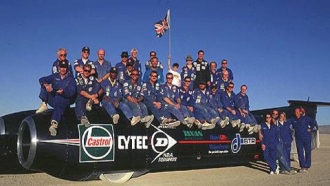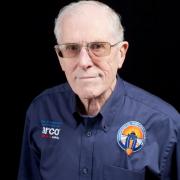By Ron Ayers

 ThrustSSC did a lot more than become the first car to exceed the speed of sound. It also smashed the previous record by a staggering 130 mph. Not only is this the biggest record margin ever, but even more amazingly, by exceeding the previous record by more than 20%, it also achieved the biggest percentage increase since land speed record breaking began. In aiming for 1000 mph we are proposing to beat even this record by another 31%. More startling still – the official air speed record at low altitude (no longer competed for) is 994 mph. We are even proposing to exceed that figure on land. Is this possible? This leads to the question: is there an absolute speed that cannot be exceeded?
ThrustSSC did a lot more than become the first car to exceed the speed of sound. It also smashed the previous record by a staggering 130 mph. Not only is this the biggest record margin ever, but even more amazingly, by exceeding the previous record by more than 20%, it also achieved the biggest percentage increase since land speed record breaking began. In aiming for 1000 mph we are proposing to beat even this record by another 31%. More startling still – the official air speed record at low altitude (no longer competed for) is 994 mph. We are even proposing to exceed that figure on land. Is this possible? This leads to the question: is there an absolute speed that cannot be exceeded?
Ever since record breaking began, the press and public have focussed on “barriers”. For instance, in 1899 when the first land speed record was set, even 100 mph seemed out of the question. Subsequently 200 mph, and then 300 mph, barriers were created in people’s minds, only to be exceeded as technology advanced. The legendary “sound barrier” was more difficult, but even that proved to be as much psychological as technical. Clearly we have to be careful when we start defining barriers or limits. At most, you can define a performance limit for a particular type of technology. For instance, although piston engined cars advanced rapidly and inexorably past 300 mph, they had real trouble beating 400 mph. John Cobb in the Railton Special, achieved 394 mph in 1947, but it was not until 1960 that 400 mph was exceeded. For several decades the record for piston engined cars was stuck at 410 mph, and only recently has it increased further. Clearly, speed “barriers” are not unbreakable, but they can be very difficult to beat.
I have no doubt that a similar limit exists for jet powered cars. With ThrustSSC we exceeded the previous record by no less than 130 mph, but I feel that we were approaching a barrier. To go much faster would require further big increases in thrust/drag ratio and thrust/weight ratio and I cannot envisage where such increases would come from. Predicting limits is much more difficult than analysing them historically, but I guess that an ultimate speed for a pure jet car would be about 800 mph, with 820 mph as a top limit. Will anyone prove me wrong?
When we commenced the BLOODHOUND SSC project it was clear that, if we were to make a really big increase on top of the 763 mph achieved by ThrustSSC, something radically different was needed. For that reason we are exploring the potential of the jet + rocket combination. However, even this technical solution must also have its ultimate limit. Where might this be? Well, our present target of 1000 mph, implying a maximum peak speed of about 1050 mph, is certainly a formidable challenge. It may indeed be close to the asymptotic limit. Let us look at the factors that will contribute to such a limit
1. Wheel design. At maximum speed the wheel rims will be subjected to 50,000g, demanding a material with extremely high strength/weight ratio. With our current wheel designs we are proposing to use an aluminium alloy, but this material is being pushed to its limits. To travel much faster would require that materials technology has advanced sufficiently to give us a material with an even greater strength/weight ratio.
2. The jet engine we are using is one of the best that currently exists. It will do the job magnificently, but has not been tested at higher speeds at such low altitudes.
3. The drag forces, already very high, will be increasing in proportion to velocity squared. The structural strength and stiffness requirements are already very extreme and will test our design skills. Although further shape optimisation may result in some drag reduction, the extra speed resulting would not be large.
4. When using a rocket we must obviously carry both the fuel and the oxidant. If we try to go even faster the weight and volume problems created by increasing the rocket size will very soon cause insuperable problems.
5. The length of currently available tracks means that high and sustained accelerations are required to achieve our target speed. Similarly, high and sustained decelerations are required to stop the car. To go even faster would mean finding a suitable track with a much greater length, or the acceleration and deceleration requirements will be totally impossible. If such tracks do exist, other factors listed above are still likely to limit the maximum speed achievable. In the current programme, we have found a magnificent track of 12 miles length. This will allow us to accelerate, achieve record speed over one mile, and decelerate within 10 miles and still allow an over-run distance at each end of at least one mile.
We have found nothing that tells us that 1000 mph is impossible. However, all of the above factors suggest that our target of 1000 mph is somewhere near to the limit of what is feasible with current technology, so the target is a very challenging one. I suggest that BLOODHOUND SSC is exploring the region between the “Sound Barrier” and the “Technology Barrier”.

